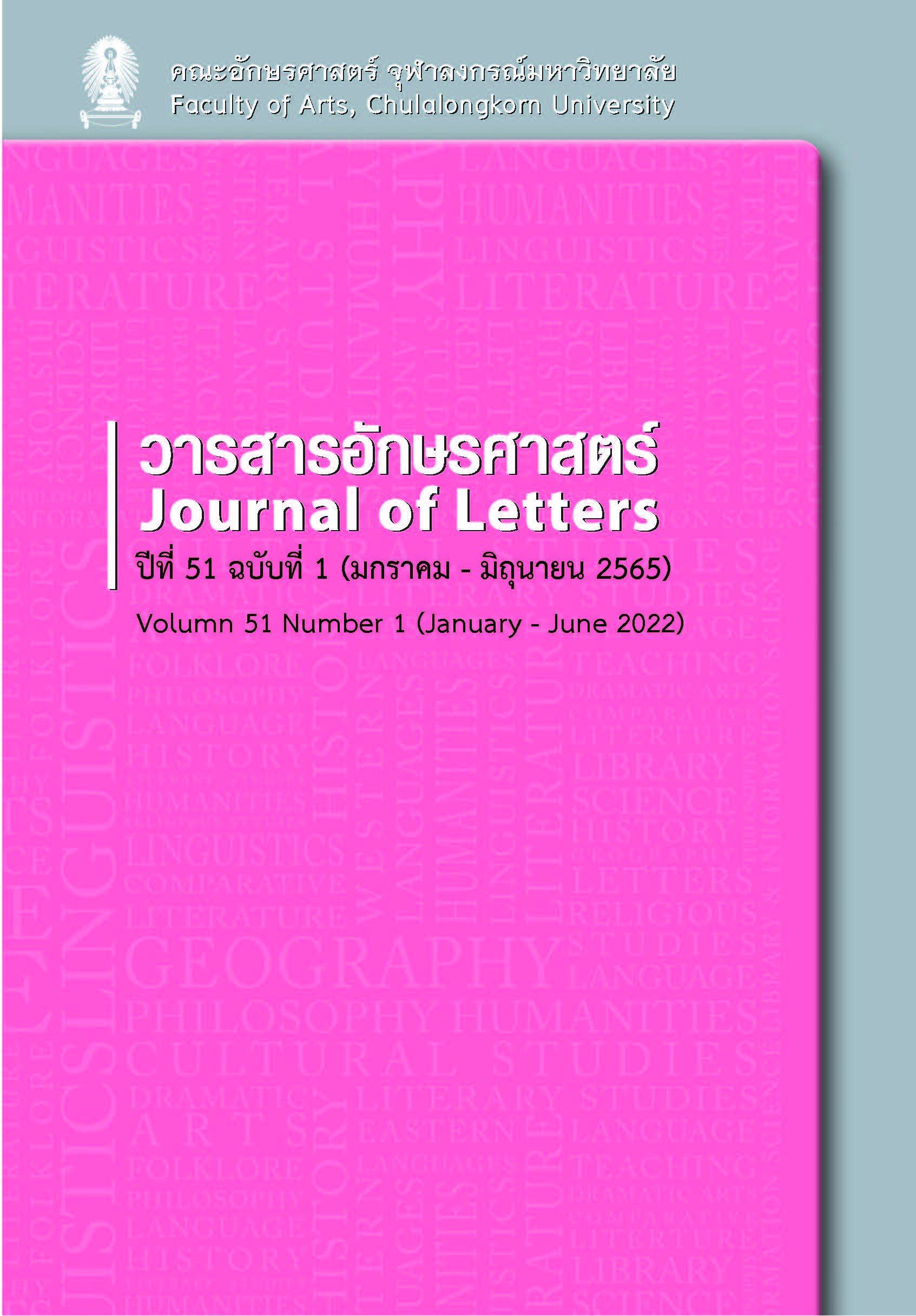The Jian group initial phoneme in Early-Mandarin :
A case study from the Hebrew-Chinese transliteration of the Pentateuch Bible
Keywords:
Transliteration, Jian group initial, Hebrew, Early Mandarin, Modern ChineseAbstract
This article presents a reconstruction of the Jian group initial phoneme in the Early Mandarin sound system (late Qing dynasty) through research into the Pentateuch Bible’s transliteration from Hebrew to Chinese. This article will include an introduction to the Bible, its translation to Chinese and the resulting analysis of the Jian group initial phoneme, with a summary of the differences in the Jian group initial between the sound system of Early Mandarin and Modern Chinese. Results show the Jian group initial in Early Mandarin represented only the [k] phoneme, while in Modern Chinese two different phonemes can be used: [k] and [tɕ]. Furthermore, the phoneme [tɕ] can be distinguished from [k] by presence of rhymes that have [i] or [y] as their medial or nucleus vowels.
References
ภาษาไทย
Biblica Thailand องค์การอมตธรรม. (2011). Prakhristham khamphi amatatham ruam samai chabap khonkhwa พระคริสตธรรมคัมภีร์อมตธรรมร่วมสมัยฉบับค้นคว้า [NIV study Bible]. Biblica.
Pranote Buskornreungrat, Seri Lorkanpai, & Neti Khuchotikul ประณต บุษกรเรืองรัตน์, เสรี หล่อกันภัย. และเนติ คู่โชติกุล. (2009). Waiyakorn pasa hebrew khong phanthasanyaderm ไวยากรณ์ภาษาฮีบรูของพันธสัญญาเดิม [Biblical Hebrew grammar]. Prachumthong Printing Group.
Thailand Bible Society สมาคมพระคริสตธรรมไทย. (2006). Benjaban chabap mattrathan เบญจบรรณ ฉบับมาตรฐาน [Standard Pentateuch Bible]. Dansuttha Printing.
Tongfang Knowledge Network Technology Co., Ltd. (Beijing) 同方知网(北京)技术有限公司. (n.d.). Karn poet thotlong chai thankhormun khong CNKI hai mahawitthayalai prathet Thai การเปิดทดลองใช้ฐานข้อมูลของ CNKI ให้มหาวิทยาลัยประเทศไทย [Trial of CNKI database for universities in Thailand]. Retrived April 27, 2022, from http://www.lib.hcu.ac.th/images/filedownload/CNKI.PDF
ภาษาอังกฤษ
Blau, J. (2010). Phonology and Morphology of Biblical Hebrew. Eisenbrauns.
Chinese Bible Translation聖經中文翻譯. (n.d.). Hehe ben 和合本 [Chinese Union Version]. Retrived April 27, 2022, from https://www.translatebible.com/chinese_union_version.html
Chinese Bible 中文聖經:和合本. (n.d.). Heheben (1919) 和合本(1919)[Chinese Union Version (1919)]. Retrived March 22, 2022, from https://biblebento.com/cuvs/cuvs.html
Gu, X. W. 顾雄伟. (2015). Tangdaimi zhou fan hanyu dui yin yanjiu-yi bu kong jingang yizhu wei zhongxin kaocha 唐代密咒梵汉语对音研究——以不空金刚译著为中心考察 [Study on Sanskrit-Chinese transliteration of Dharani Sutra in Tang Dynasty—Resource from Amoghavajra’s transliteration Works] [Doctoral thesis]. Fudan University.
Hong Kong Bible Society 香港聖經公會. (2006). Shengjing-Hehe ben (Shen ban) 聖經—和合本(神版)[The Holy Bible – Chinese Union Version (Shen-Edition)]. Hong Kong Bible Society.
Huang, X. M. 黃錫木. (2004). Shengjing fangyi he chuanbo zhi liu huaren shengjing fanyi de gongzuo (xia) 「聖經翻譯和傳播」之六華人聖經翻譯的工作(下)["Bible translation and dissemination" - The work of six Chinese Bible translations (Part 2)]. Retrived March 22, 2022, from http://occr.christiantimes.org.hk/art_0073.htm
Kittel, R. (1997). Biblia Hebraica Stuttgartensia. Deutsche Bibelgesellschaft.
Li, X. K. 李新魁. (1983). “Zhongyun yinyun” yin xi yanjiu《中原音韵》音系研究 [Study on sound system of Zhongyuanyinyun]. Zhongzhou Shuhua Press.
Liu, J. 刘俊. (2008). Shengjing fanyi shi圣经翻译史 [History of Bible translating]. Jilin sheng jiaoyu xueyuan xuebao 吉林省教育学院学报 [Journal of College of Education of Jilin] 24, 78-79.
Liu, X. N. 刘晓南. (2007). Hanyu yinyun yanjiu jiaocheng 汉语音韵研究教程 [Textbook in research of Chinese phonology]. Peking University Press.
Rendsburg, G. A. (1997). Ancient Hebrew phonology. In A. Kaye (Ed.), Phonologies of Asia and Africa (pp. 65-83). Eisenbrauns.
Tang, Z. F. 唐作藩. (1991). Yinyun xue jiaocheng 音韵学教程 [Chinese phonology textbook]. Peking University Press.
Wang, L. 王力. (2015). Hanyu shi gao 汉语史稿 [History of Chinese]. Zhonghua Book Company.
Ye, B. K. 叶宝奎. (2001). Ming qing guan huayin xi 明清官话音系 [Sound system of Ming-Qing period Mandarin]. Xiamen University Press.
You, C. R. 尤垂然. (2019a). Hehe ben jian shi he fanyi shilue (shang)《和合本》简史和翻译策略(上)[A brief history and translation of “Chinese Union Version” (Part 1)]. Retrived October 10, 2020, from http://www.christianweekly.net/2019/sa2037636.htm
You, C. R. 尤垂然. (2019b). Hehe ben jian shi he fanyi shilue (xia)《和合本》简史和翻译策略(下)[A brief history and translation of “Chinese Union Version” (Part 2)]. Retrived October 10, 2020, from http://www.christianweekly.net/2019/sa2037780.htm?fbclid=IwAR21Zlo43knUQkaWeo6B_5wR8qMRRCvvEPXDaJVkxYZ4TxQuV3_-OVSXrYk
Zhang, B. 张斌. (2018). Xin bian xiandai hanyu 新编现代汉语 [Newly edited modern Chinese]. Fudan Press.
Downloads
Published
How to Cite
Issue
Section
License

This work is licensed under a Creative Commons Attribution-NonCommercial-NoDerivatives 4.0 International License.
Copyright and plagiarism
Authors are responsible for obtaining permission to use copyrighted materials from copyright owners. Authors are responsible for observing requisite copyright law when quoting or reproducing copyrighted materials. Quotations and reproductions of content from other published sources must be accompanied by a reference and all sources should be clearly listed in the references section. Quotations and reproductions of content from external sources without due attribution could be considered a severe infringement of academic conduct and may constitute a legal offence under the Copyright Act of B.E. 2537. Any legal ramifications arising from the infringement of copyright regulations would be the sole responsibility of the author(s).



